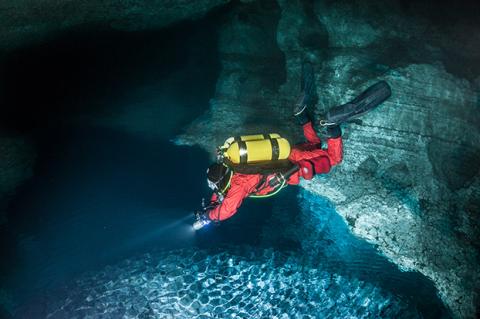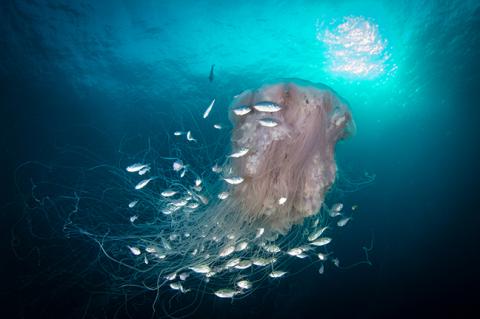X-Ray Mag #78
Main features in this issue include:
Austrian Lakes: Grübl See & Grüner See
Austria offers divine diving at high altitudes in freshwater lakes. Marco Daturi takes us to two beautiful lakes found in the mountains of Styria—one that continues to enthrall and one which has recently been closed for conservation and protection.
Grübl See
Diving with Dinosaurs: The Galápagos Marine Iguana
The Galápagos archipelago, a chain of islands in the Pacific Ocean about 600 miles off the coast of Ecuador, is like no other place on earth. More than a hundred islets, rocks and 13 main islands make up the Galápagos. It is home to strange creatures found nowhere else. This is one of the few places in the world where you can scuba dive and snorkel with animals which remind one of the dinosaurs of ages past.
The marine iguana (Amblyrhynchus cristatus), found only in the Galápagos Islands, is a marine reptile that closely resembles the movie adaptation of Godzilla. It has the unique ability among modern lizards to forage for food in the sea.
Forgotten Wrecks of Laredo
Croatia, Italy, France—these European destinations have long been coveted insider knowledge for technical and wreck divers. But what about Spain? Technical diving is still in its infancy in Spain. Nevertheless, there are some dive centers in the Mediterranean, as well as on the Atlantic coast of Europe, which offer trimix. There are countless worthwhile destinations in Spain.
The Atlantic is unpredictable. If you want to do technical wreck diving off the coast of northern Spain, you must be flexible enough to deal with conditions that change very quickly.
Inert Gas Narcosis – Part 1
The change in the physical behavior of gases at elevated pressures and in the hyperbaric environment itself exposes the human body to various stressors. This article—which will be presented in two parts—discusses inert gas narcosis (ING) and how it affects the diver, the mechanism behind narcosis, and methods used in order to ameliorate the negative impact of narcosis on divers.
In a mixture of gases, Dalton’s law of partial pressures explains the relation between the total pressure exerted and the partial pressures of the individual gases. As the absolute pressure increases, the partial pressures of nitrogen and oxygen—in a mixture of air—will also increase.
Maldives: The Central Atolls
I was not planning to go on the night dive. It was the first night of the trip and I was a little tired, I already had my camera batteries charging and was all settled in with a book for the night after a fabulous first day of diving with turtles, sharks and tons of fish. But Fernando, our dive guide, told me I had to go.
The dive site was Alimatha Pier at Vaavu Atoll. We did our giant strides into the black water and were immediately greeted with a ripping current. They said to bring reef hooks if you had them (which I did not), so after getting to the bottom, I found a rock to hold on to.
Nudibranch Macro: Going Beyond the ID Photo
Nudibranchs are a worldwide favorite for macro photographers, often leading divers on a “wild slug hunt” across the globe. Once these little gems capture your attention, it is very hard to break out of their magic spell. A gateway critter, if there ever was one, the nudibranch combines the beauty of our ocean and natural history in a photogenic and scientific symphony like no other marine animal.
Often referred to as slugs due to their evolutionary path, the grand designs of nudibranchs are as fascinating and varied as there are slugs themselves.
On the Other Side of the Ice: Ice Diving Competition in Russia
If your home reef is covered in ice, do not rush to hang your fins on the wall. Ice above your head will make your underwater photos more spectacular! As the cold season has started where I live (in the Russian Far East), more and more divers are coming to dive the East Sea. This year, the Second World Open Diving Championship in “Under-Ice Direction Finding” was held in Vladivostok by the National Dive League of Russia.
As is now tradition, the championship took place in Novik Bay in February. The ice on the sea is the most stable during this month. Preparation for the competition was carried out over several weeks.
Robert Paris Portfolio
Originally from Virginia, American artist Robert Paris grew up loving the outdoors and the natural world around him. After a career in graphic design working with marketing groups, he decided to give up the corporate life and pursue his passion for painting.
"I was born with a creative gene, which drives me every day. I try to create something positive for others to enjoy."
— Robert Paris
X-RAY MAG: Tell us about yourself, your background and how you became an artist.
The Role of Ego in Technical (and Recreational) Diving
I read a blog recently that suggested our egos could be responsible for many of the casualties that technical diving regrettably suffers. Sadly, my comments on this blog never made it past the moderator. As a scientist and psychologist, I am somewhat protective of terminology used to describe human thought, emotion and behaviour, and the author of this blog fell into a common trap in how one described ego.
Ego simply refers to self and how we feel about ourselves. This results in our thoughts, emotions and behaviour. Where an ego is arrogant, overbearing, misguided or delusional, then bad things can and often do happen.
Treasures of Tasmania
There is an island at the bottom of the Earth playfully referred to as the end of the world, or the edge of the world, and if I did not know better, I could picture this to be true. Standing at the edge of some of the steepest cliffs in Australia on the Tasman Peninsula of southeastern Tasmania, I looked out over the steep, jagged coastline and the steel blue Southern Ocean.
The previous day, I was at the other end of these cliffs and 10m underwater, getting my first glimpse of weedy seadragons, a unique and strangely beautiful marine organism endemic to southern Australia.
What exactly is meant by "Rebreather Friendly"?
“Rebreather Friendly” dive centres—what exactly does this mean? With emerging technologies becoming more mainstream in the diving world these days, more and more people are making the investment in rebreathers. Everyone knows the advantages of these pieces of kit—extended dive time capabilities, reduced gas usage, quieter and less obtrusive to the aquatic world, etc. But are dive operators thinking on the same lines?
With the advent of PADI’s recreational closed circuit rebreather (CCR) dive programmes announced in late 2011, it was anticipated that there would be a tidal wave of interest by the diving public learning on rebreathers to capitalise on the advantages of rebreather diving, and dive shops would be
You are on your own! A hard look at the buddy system
In this issue, Simon Pridmore takes a look at the buddy system and concludes that on many occasions your buddy is not your friend, and you would be much better off assuming that this will be the case and preparing yourself, always, to assume full responsibility for your diving.
The buddy system, as it was originally conceived, was a procedure whereby two confident divers operate as independent members of a two-person team—with their shared equipment, experience and gas supply—making the team stronger and safer than its individual members acting alone.














